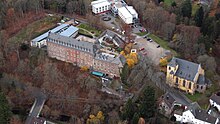Schleiden
Sub-divisions
The borough of Schleiden is divided into 18 settlements (population figures of those at their main residence as at September 2020):
| Settlement | Population |
|---|---|
| Berescheid | 192 |
| Broich | 375 |
| Bronsfeld | 572 |
| Dreiborn | 988 |
| Ettelscheid | 275 |
| Gemünd | 3,868 |
| Harperscheid | 426 |
| Herhahn | 463 |
| Kerperscheid | 80 |
| Morsbach | 556 |
| Nierfeld | 451 |
| Oberhausen | 838 |
| Olef | 1,120 |
| Scheuren | 371 |
| Schleiden | 2,289 |
| Schöneseiffen | 424 |
| Wintzen | 85 |
| Wolfgarten | 209 |
| Total | 13,582 |
Neighbouring municipalities
- North: Heimbach (Eifel) (County of Düren)
- East: Mechernich, Kall (both in the county of Euskirchen)
- South: Hellenthal (County of Euskirchen)
- West: Monschau, Simmerath (both in the Borough of Aachen)
History
County of Luxembourg 1271–1353
Duchy of Luxembourg 1353–1795
French Republic 1795–1804
French Empire 1804–1815
Kingdom of Prussia 1815–1871
German Empire 1871–1918
Weimar Republic 1918–1933
Nazi Germany 1933–1945
Allied-occupied Germany 1945–1949
West Germany 1949–1990
Germany 1990–present


In the Middle Ages and Early Modern times, Schleiden was the centre of a lordship, later the County of Schleiden, which itself was part of the Duchy of Luxembourg, from 1441/43 as part of the Burgundian Netherlands (first under the Burgundians, then the Habsburgs). After the division of the Netherlands, the Duchy of Luxembourg with Schleiden remained as part of the Spanish line of the Habsburgs. After the War of Spanish Succession, the Duchy of Luxembourg, along with Schleiden, went to the Austrian line of the House of Habsburg. When revolutionary France conquered the Austrian Netherlands in 1794/95, the Duchy of Luxembourg was quickly divided into the three French departments: Forêts, Sambre-et-Meuse and Ourthe. Schleiden was in Ourthe (capital: Liege). At the Vienna Congress of 1815, the formerly Luxembourgian areas east of the Our, Sauer and Moselle rivers were given to the Kingdom of Prussia. Thus, Schleiden became "Prussian" and, in 1871, part of the German Empire after having belonged to the Duchy of Luxembourg for centuries.
The small town of Schleiden has produced two important Christian humanists: Johannes Sleidanus and Johannes Sturm, also known as Ioannes Sturmius.
In 1944 the Battle of Wahlerscheid took place nearby.
Mayors
- 1972−1975: Max Fesenmeyer (independent)
- 1975−1984: Herbert Hermesdorf (1914-1999) (CDU)
- 1984−1995: Alois Sommer (CDU)
- 1995−1997: Dieter Wolter (CDU)
- 1997−2004: Christoph Lorbach (CDU)
- 2004−2012: Ralf Hergarten (independent)
- 2012–2018: Udo Meister (FDP)
- 2018– : Ingo Pfennings (CDU)
Education
There are the following schools in the city:
- Municipal Johannes-Sturmius-High School
- Clara-Fey-High School, Schleiden (carrier is the diocese of Aachen)
- Municipal Secondary School
- Primary school
- Elementary school
- Elementary school Gemünd
- Elementary school Dreiborn
- Astrid Lindgren School, Schleiden

Sights


- Castle and church (1230 castle chapel, 1516–1525 late Gothic hall church, König organ from 1770)
- From 1900 to 1905 the Urft Dam was built as the largest dam in Europe at the time. Today it is part of the Eifel National Park.
- Ordensburg Vogelsang on the former Vogelsang Training Area
- "Tempelchen" war memorial for the victims of the Franco-Prussian War of 1870/71 and the First World War
- Jewish Cemetery
- Forest Experience Centre
Olef Valley Railway

The Olef Valley Railway (from Kall to Hellenthal) stopped at Schleiden station; regular passenger services were discontinued by Deutsche Bundesbahn in 1981. Because of the Eifel National Park, which was newly established in 2004, the state of North Rhine-Westphalia is supporting tourism with a two-year programme of passenger services in the tourist season on Sundays and public holidays. These services terminated in 2004 in the district of Gemünd, and in 2005 they continued to Schleiden. The regional railway was managed by the Verkehrsverbund Rhein-Sieg; Rurtalbahn was the operator. Regular traffic ended on 16 October 2005. Since 2006 services have been operated privately as a museum railway in the summer season, with the 2008 season being operated by the Rhein-Sieg-Eisenbahn. From 2010, the trains will run again to Hellenthal station, using an historic MAN railbus. Due to massive damage caused by the 2021 European floods, museum railway services were suspended.
Until 1997 there was regular freight traffic via Schleiden to Hellenthal, after that only military traffic to Schleiden-Höddelbusch (tank loading ramp). The last troop loading took place there in winter 2002 with diesel and steam locomotives from a private railway. Belgium handed back the Vogelsang Training Area on 1 January 2006. The training area on the Dreiborn Plateau was turned over to non-military use and has a documentation centre and hiking area.
Public figures

- Johannes Sturm (Sturmius) (1507–1589), educator and scholar of the Renaissance, a professor in Paris and founder of the University of Strasbourg
- Johannes Sleidanus (1506–1556), historian, professor, Schleiden / Strasbourg
- Leopold Schoeller (1792–1884), industrialist and Privy Councillor of Commerce
- Gustav Poensgen (1824–1904), industrialist and Privy Councillor of Commerce
- Rudolf Poensgen (1826–1895), industrialist and councillor of commerce
- Carl Poensgen (1838–1921), industrialist and Privy Councillor of Commerce
- Larres Albert (1900–1987), painter
- Francis Albert Heinen (born 1953), journalist and nonfiction writer
- George Schreiber (born 1958), photographer
- Vera Hilger (born 1971), painter
References
- ^ Bürgermeisterstichwahl Stadt Schleiden, accessed 20 June 2021.
- ^ "Bevölkerung der Gemeinden Nordrhein-Westfalens am 31. Dezember 2023 – Fortschreibung des Bevölkerungsstandes auf Basis des Zensus vom 9. Mai 2011" (in German). Landesbetrieb Information und Technik NRW. Retrieved 2024-06-20.
- ^ "Einwohnerzahlen im Regierungsbezirk Köln". Information und Technik Nordrhein-Westfalen: Statistik. it.nrw.de (accessed 24 June 2018).
- ^ Stadt Schleiden:Bevölkerungsstatistik (pdf; 20 kB)
- ^ http://www.schleiden.de/sv_schleiden/Rathaus/Rathaus%20&%20Politik/Rathaus/Verwaltungsorganisation/Verwaltungsf%C3%BChrung%20seit%201972 administration since 1972 homepage of the town Schleiden
- ^ Wolfgang Kirfel (2021-08-28). "Zukunft der Oleftalbahn ungewiss: 90 Prozent der Strecke wurden von der Flut zerstört". Retrieved 2021-09-08.
- ^ Militärzug am 28. Januar 2002 in Schleiden

